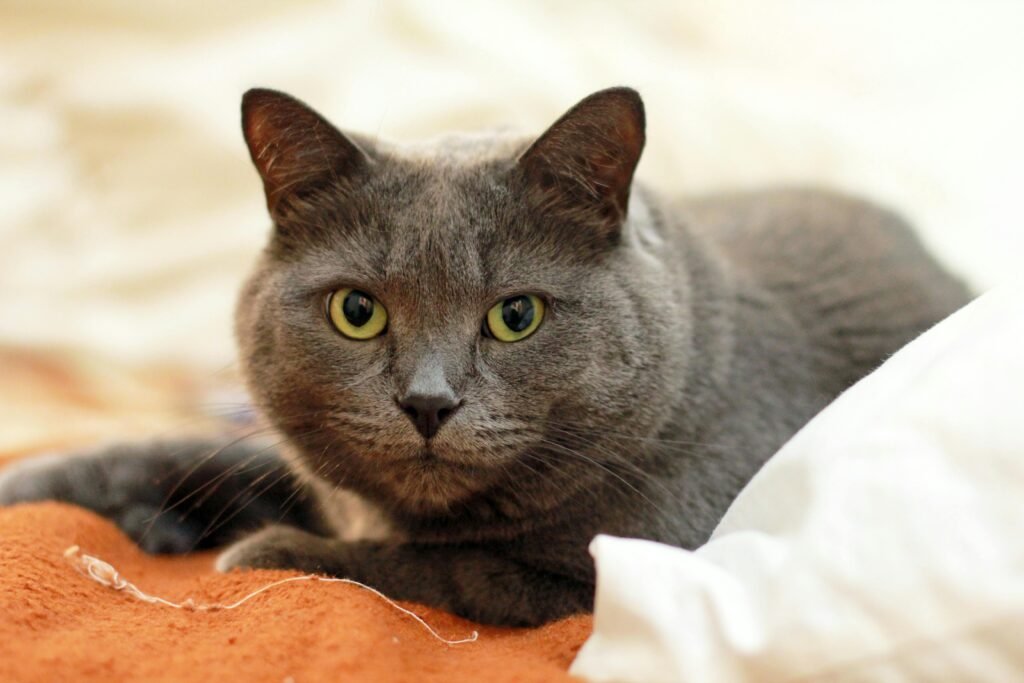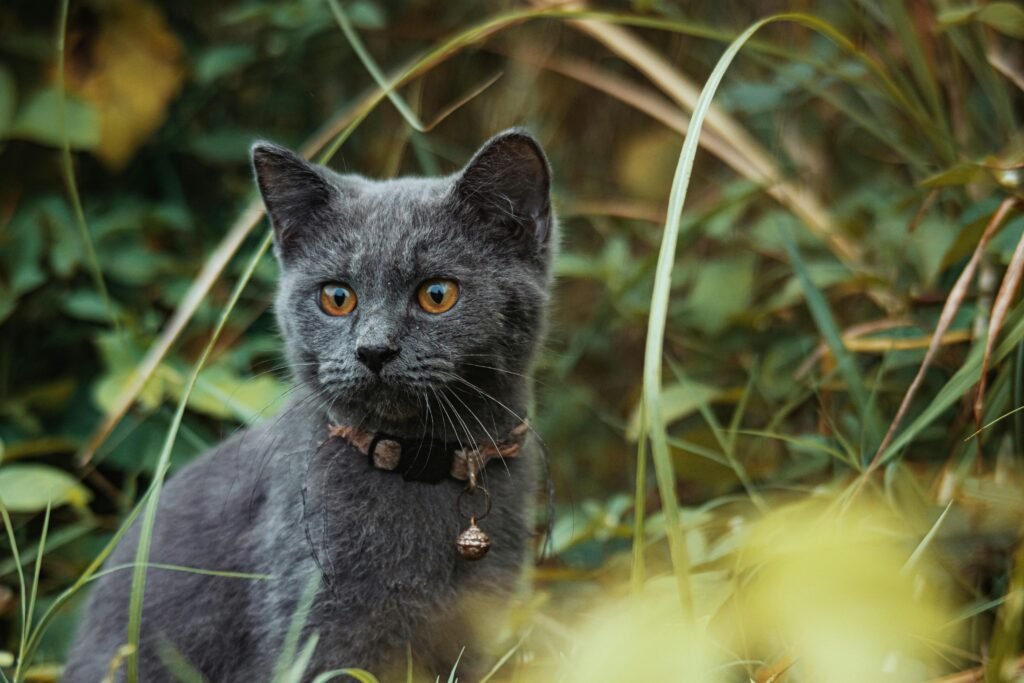Table of Contents
Introduction
The Russian Blue cat is one of the most beloved cat breeds worldwide due to its friendly temperament, elegant appearance, and easy-going lifestyle. The remarkable beauty and appealing personality of the Russian Blue cat are well-known. Its short, dense coat, which appears silver-blue and gives the cat an attractive, shimmering appearance, is one of its most distinctive features. For owners who enjoy low-maintenance dogs, this double-layered fur is perfect because it is pleasant and requires little brushing.
Russian Blues have bright green, almond-shaped eyes that contrast nicely with their grayish-blue fur. Their body is robust but thin, and they have long legs and an elegant, regal walk.
Russian Blue cats are quiet, and kind personality. Although they are devoted companions and develop close relationships with their owners. They might come across as bashful with strangers. They are not extremely talkative. They interact with humans through soft meows and body language.
They are highly intellectual and like regular playtime, puzzles, and interactive toys. They have proved their ingenuity and interest by learning tricks and even opening doors.
Russian Blues are perfect for peaceful homes or apartments due to their cleanliness, and quietness. They are the ideal companion for people or families seeking a serene, elegant, and loving pet with a sense of mystery and sophistication because of their caring but autonomous character.
Frequently known as:
- Blue Russian
- Archangel Blue, which alludes to its alleged place of origin
- Russian Blue Shorthair

History and Origin
It is widely believed that the Russian Blue cat breed originated in the coastal city of Arkhangelsk (Archangel) in northern Russia, while its exact origins are still unknown.
These cats are believed to have been introduced to England and Northern Europe in the 1860s by sailors.
The breed was first introduced as the Archangel Cat at a cat show in London in 1875. It was gradually selectively bred in Scandinavia and Britain, which contributed to the development of the distinctive characteristics that define the modern Russian Blue.
Physical Characteristics
The Russian Blue cat is famous for its graceful body. Here are a few of its salient physical characteristics:
- Coat: Soft-textured, double-layered, short, and dense.
- Body: Long legs, small, delicate paws, muscular yet slender.
- Tail: tapered and long
Personality and Temperament
There is more to the Russian Blue than just a lovely face. It is well known for being intelligent and kind. Among the noteworthy characteristics of the personality are:
- Kind yet Reserved: They develop close relationships with their humans but may be reserved around new people.
- Intelligent: They are able to pick up commands, tricks, and even the opening of cabinets or doors.
- Loyal: Known to stroll around the house after their favorite person.
- Calm and quiet: They frequently use gentle meows and gestures to communicate instead of being overly talkative.
Russian Blue cats make excellent companions for families.
Russian Blue Cat Care Guide
Russian Blues are slightly low-maintenance pets. However, Russian Blues need constant care to grow.
Basic Care Requirements:
- Playtime every day to keep them from getting bored and to keep their minds active.
- Cat scratching posts to settle their natural desires.
- A hygienic litter box, since they are really picky.
Nutrition and Diet
Russian Blue cats, like other cats, must eat a lot of protein because they are obligate carnivores.
Feeding Tips:
Choose premium commercial cat food with meat as the primary ingredient, whether it is wet or dry. This breed is prone to weight gain, so limit the amount of treats they are given, and make sure there is always fresh water accessible. Regular veterinary exams can be used to track weight and overall health.
Grooming Needs
The Russian Blue cat has minimal grooming needs.
Grooming Tips: The minimal grooming needs of a Russian Blue cat are among its greatest advantages.
- Brush once a week to minimize shedding loose fur.
- Every two to three weeks, trim your nails.
- Regularly brush cats’ teeth and clean ears.
They are relatively easy to maintain and don’t shed much because of their short, thick coat.
Health and Lifespan
Although the Russian Blue breed is strong and healthy. Like all cats, they are at risk of certain illnesses.
Common Health Concerns:
Typical health issues include:
- Obesity (if overfed)
- Dental disease and a few uncommon hereditary disorders
If given the proper care, the Russian Blue cat can live for 15 to 20 years as a companion.
Living Environment
Russian Blues are highly adaptable and do well in both apartments and larger homes.
- Calm and quiet homes
- Living indoors exclusively to safeguard their health and safety
- Using enrichment tools like puzzle feeders and climbing shelves
They prefer routines and their own space due to abrupt changes that might be upsetting to them.

Are Russian Blue Cats Hypoallergenic?
While no cat breed is completely hypoallergenic, Russian Blue cats are frequently seen as a decent option for those with allergies. These elegant cats generate less of the glycoprotein Fel d 1, which is the primary allergy found in cat dander, skin, and saliva. As a result, compared to other breeds, some allergy fatalities may have fewer or less severe symptoms when around Russian Blues. Regular cleaning and brushing are still necessary to reduce the accumulation of allergies. However prospective owners with allergies must spend time with a Russian Blue before bringing one home, even though they are known to be hypoallergenic.
Here is a list of health issues and diseases that Russian Blue cats can be prone to:
- Obesity: This is a result of their propensity for inactivity, particularly when keeping in-house.
- Hypertrophic Cardiomyopathy (HCM): This is a heart condition that damages the heart muscle.
- Progressive Retinal Atrophy (PRA): This less prevalent but potentially fatal degenerative eye condition can cause blindness.
- Problems with the urinary tract, such as infections or crystals, are widespread if one is dehydrated.
- Diabetes Mellitus: Associated with weight control and diet.
- Dental Disease: If dental hygiene is neglected, it might manifest as periodontal disease or gingivitis.
- Rare but possible in certain lines is polycystic kidney disease (PKD).
- Skin or digestive problems may result from food allergies or sensitivities.
- Respiratory Infections: These usually occur in kittens or those who have been around infectious animals.
- A collection of disorders affecting the bladder and urethra is known as feline lower urinary tract disease (FLUTD).
- Feline lower urinary tract disease (FLUTD) affects the bladder and urethra.
With the right care, Russian Blues can live for 15 to 20 years, but prevention and early detection depend on routine veterinary examinations and a good diet.
Training and Socialization
Russian Blue cats are trainable thanks to their intelligence.
Training Advice:
- Apply strategies for positive reinforcement, such as praise and treats.
- To keep their minds active, utilize interactive toys and teach them simple commands.
- It takes advantage of socializing with people and other pets at a young age.
Daily play is advised since they thrive on mental and regular stimulation.
Final Thoughts
The Russian Blue cat breed is the perfect companion for those seeking a pet that combines intelligence and beauty in equal measure. They are a wonderful addition to many kinds of homes because of their remarkable look, kind nature, and low maintenance requirements.
The Russian Blue’s very intelligent and quiet nature will bring peace and love to your everyday life, regardless of whether you live alone or have a busy family. The Russian Blue might be the ideal choice if you’re prepared to make a long-term commitment to a feline companion.
1- What is the personality of a Russian Blue?
Russian Blues are intelligent, quiet, and affectionate with their families but can be shy or reserved around strangers. They are also known for being playful and loyal.
2- Do Russian Blues require a lot of grooming?
Not really. Their short, plush double coat requires minimal grooming—brushing once a week is usually sufficient to remove loose hair and keep the coat shiny.
3- Are Russian Blue cats good with children and other pets?
Yes, Russian Blues are typically good with children and can get along well with other pets, especially if they are socialized from a young age.
4- Are Russian Blues easy to train?
Yes, they are very intelligent and can learn tricks, commands, and even how to play fetch. They respond well to positive reinforcement.